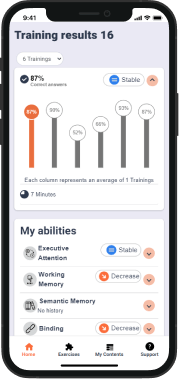
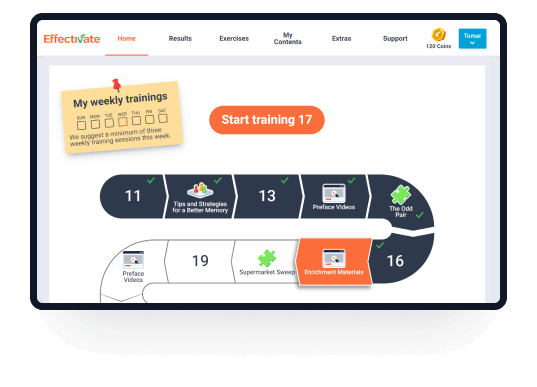
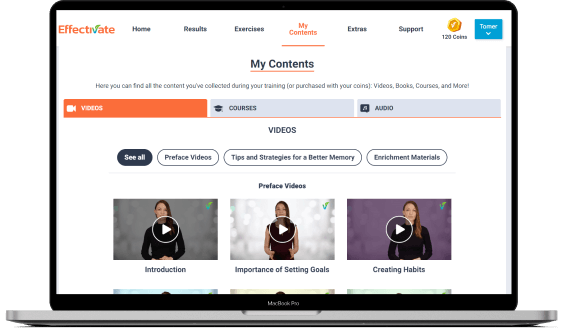
Cognitive games tailored for
your needs

What is Brain Training?
Brain training involves exercises designed to enhance memory, focus, and problem-solving skills. These activities help build new neural connections, keeping the mind sharp and agile. From puzzles to strategic games, it’s a way to boost mental performance at any age. Regular practice can improve focus, creativity, and overall cognitive health.
Our Training Capabilities
Attention is the ability to actively process specific information while tuning out other details in the environment. It is often simulated as an inner spotlight that we turn to our senses in order to receive new information. Attention is partially involved in most of our thinking processes: we need attention to take in new information, we need to maintain stable attention to stay focused, and we can even decide which information we want to process and which information we want to ignore. Attention plays a crucial role in processing the information that comes to our minds. Without it, it is almost impossible to create new memories. Attention is a limited resource, forcing us to be selective about what we decide to focus on.
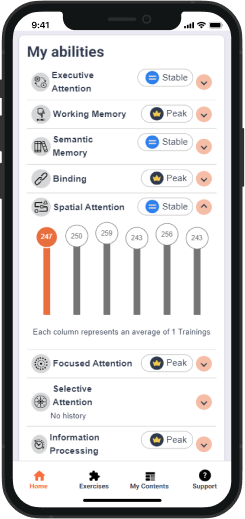
Our working memory holds all of the information we need to perform a particular task. This information can be received from our senses (sight, hearing, smell, etc.) or we can extract it from the vast store of information we have in our long-term memory. The working memory connects all of the necessary pieces of information in order to achieve the desired result. The information that is held by the working memory can then be manipulated.The capacity of working memory is limited, however: the average person can hold roughly five items in their working memory at a given time.
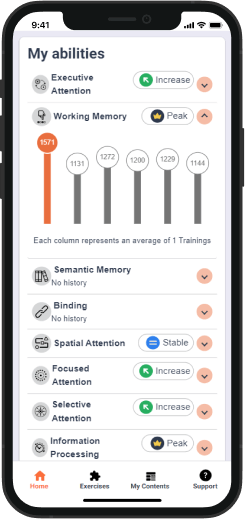
Binding is the “gluing” together of different pieces of information. One type of binding is between different dimensions of the same object. For example, when we see a basketball, one part of the brain is responsible for perceiving the orange color, another for perceiving the round shape, a third part for capturing the smell of the rubber, and another part for linking these features together to create a full object that we call a basketball. In other words, binding is responsible for connecting different features into a single object with a specific meaning. Thus, an orange basketball is different from a blue basketball, and an orange basketball is different from an orange (despite them being the same shape and color).
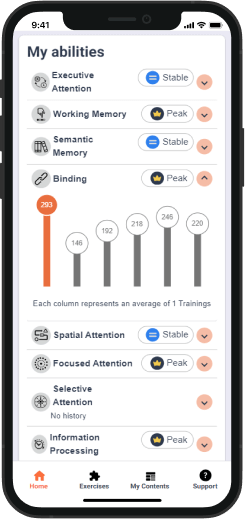
Spatial attention is a type of attention that refers to the division of our awareness in space, such as our field of vision. Directing attention to a specific area in space allows us to better absorb the information contained in it, such as being able to identify a certain object or to distinguish between an object and its background. It is important to pay attention to the entirety of our visual field, so as not to miss important things that may be happening in our environment.

Cognitive flexibility is a mental process of shifting focused attention from one concept to another. We can do it consciously, for example when trying to think like another person, or unconsciously. Cognitive flexibility refers to our ability to alter our perspective and behavior in response to changes in our environment in order to achieve a desired outcome. Having difficulties with this ability can restrict our range of responses.

Information processing is the initial process of identifying and analyzing the information received to the brain from the senses. The brain’s ability to efficiently understand, analyze, process, and send information depends on a number of factors, particularly the quality and quantity of neural connections between the brain cells. For example, when we see an image of 3 connected lines, the brain picks up that information, compares it to existing information stored in long-term memory, and comes to the conclusion that it is a triangle. This is the mechanism of information processing.

The executive attention system is our brain’s cognitive “manager”: when our attention is pulled in several directions, the executive attention system manages how the brain should act and where we should direct our attention. For example, when two things are happening simultaneously, the executive attention system will decide which event we should respond to first. Executive attention is what allows us to identify errors, make quick decisions in risky situations, and overcome bad habits by suppressing automatic actions. This ability also helps us with day-to-day cognitive challenges such as regulating emotions, delaying gratification, and long-term planning.
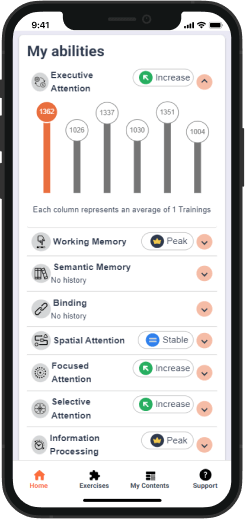
Spatial attention is a type of attention that refers to the division of our awareness in space, such as our field of vision. Directing attention to a specific area in space allows us to better absorb the information contained in it, such as being able to identify a certain object or to distinguish between an object and its background. It is important to pay attention to the entirety of our visual field, so as not to miss important things that may be happening in our environment.
Our working memory holds all of the information we need to perform a particular task. This information can be received from our senses (sight, hearing, smell, etc.) or we can extract it from the vast store of information we have in our long-term memory. The working memory connects all of the necessary pieces of information in order to achieve the desired result. The information that is held by the working memory can then be manipulated.The capacity of working memory is limited, however: the average person can hold roughly five items in their working memory at a given time.
Binding is the “gluing” together of different pieces of information. One type of binding is between different dimensions of the same object. For example, when we see a basketball, one part of the brain is responsible for perceiving the orange color, another for perceiving the round shape, a third part for capturing the smell of the rubber, and another part for linking these features together to create a full object that we call a basketball. In other words, binding is responsible for connecting different features into a single object with a specific meaning. Thus, an orange basketball is different from a blue basketball, and an orange basketball is different from an orange (despite them being the same shape and color).
The word “semantics” means “meaning”. Semantic memory is the complete collection of general knowledge we have accumulated over the years. It is a memory of general knowledge and facts, which includes virtually everything we know about the world around us. Semantic memory contains information about the identity and characteristics of various objects – which can be concrete things like “table” or “dog”, as well as abstract things like “invention” or “democracy”. Semantic memory not only represents the individual objects, but also the different connections between them. All in all, semantic memory allows us to understand and decipher the world.
Cognitive flexibility is a mental process of shifting focused attention from one concept to another. We can do it consciously, for example when trying to think like another person, or unconsciously. Cognitive flexibility refers to our ability to alter our perspective and behavior in response to changes in our environment in order to achieve a desired outcome. Having difficulties with this ability can restrict our range of responses.
Information processing is the initial process of identifying and analyzing the information received to the brain from the senses. The brain’s ability to efficiently understand, analyze, process, and send information depends on a number of factors, particularly the quality and quantity of neural connections between the brain cells. For example, when we see an image of 3 connected lines, the brain picks up that information, compares it to existing information stored in long-term memory, and comes to the conclusion that it is a triangle. This is the mechanism of information processing.
The executive attention system is our brain’s cognitive “manager”: when our attention is pulled in several directions, the executive attention system manages how the brain should act and where we should direct our attention. For example, when two things are happening simultaneously, the executive attention system will decide which event we should respond to first. Executive attention is what allows us to identify errors, make quick decisions in risky situations, and overcome bad habits by suppressing automatic actions. This ability also helps us with day-to-day cognitive challenges such as regulating emotions, delaying gratification, and long-term planning.








Partnering with AARP to deliver brain training solutions that support a vibrant and active lifestyle for the 50+ community.
What Our Users Are Saying
My experience with the software has been very positive, and I practice several days a week. There is a scientific explanation and logic for each exercise, as well as goals for each. A statistical analysis of my personal progress shows me my strengths and weaknesses at the end of the practice.
A year ago, I began “playing” with the program. My progress has been significant. My daily life is affected by it. Furthermore, I enjoy being challenged and seeing my progress in graphs and numbers, and as a bonus it helped me gain a greater awareness of myself
Since I have been training for several months, I have noticed an improvement in my memory. The exercises are mostly enjoyable and the staff is cooperative and polite.
This software is great for improving memory, reaction speed, orientation, and other skills required in everyday life. My recommendation is Effectivate, which adapts abilities and upgrades difficulty according to the user’s pace. It’s magnificent!
Effectivate provides interesting exercises that I enjoy practicing three times a week. My opinion is that special exercises that stimulate different parts of the brain (sound memory, face memory, distinguishing between different parts, memorizing lists, etc.) are both interesting and beneficial.
It has been almost two years since I started practicing in Effectivate. As a result of the practice, my memory seems to be improving. Occasionally, new exercises are added and the exercises change. Every workout challenges him and he highly recommends it!
The practice and enjoyment of it have been ongoing for a long time – I’m sure it has also yielded results. The experience was so great that I recommended it to all my relatives. This is a convenient training that does not require much time and can be done at any time.
It’s been almost six months since I started training Effectivate. Not only do I enjoy it, but I also learn from it! My memory and concentration are improving. My daily life is improved by the training; I am more confident and able to believe that there are tools I can use to avoid stumbling.
As often as possible, I train correctly, play, and have fun, for a total of 20 minutes a week. Brain-boosting. I feel the effectiveness of the nice practice. Both my reading speed and short-term memory have improved. As far as I am concerned, I feel fine and am even making progress. I highly recommend this product. Also, my husband subscribes and is very pleased with it.
Cognitive training may be offered to older adults with normal cognition and with mild cognitive impairment to reduce the risk of cognitive decline and/or dementia. Strength of the recommendation: conditional
In July 2021, Jacob, 77 years old. He has shown amazing improvement in accuracy on the star assignment. His graphs show an increase of 50% or more at specific exposure times. Jacob renewed his subscription this week, and this will be his third year training with the software. He is one of thousands of clients who have made cognitive training a part of their daily lives.
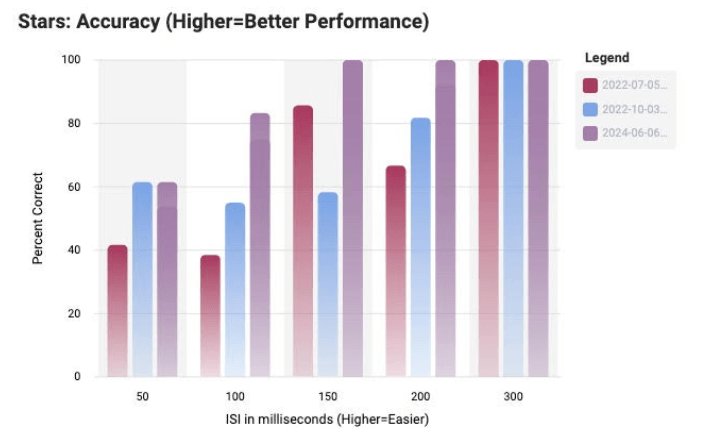
Mason 69-year-old reduced his response time by 40%! The result was measured using the star test, which measures processing speed. The first test and the last were taken about two and a half years apart, during which Mason completed 380 training sessions. He is one of thousands of clients who understand the importance of cognitive training.
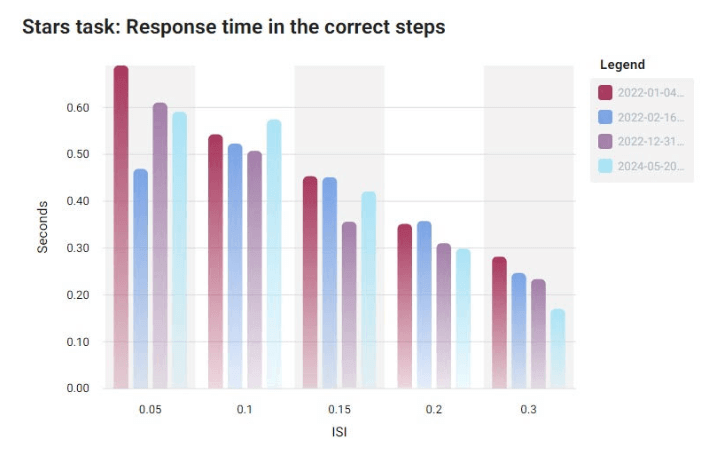
Olivia, 64 years old, reached 829 training sessions! She recently completed 4 years in Effectivate and has renewed her subscription for a fifth year. On average, Olivia completes 4 training sessions a week (3.83). So far, Olivia has had 11 assessment tests. Olivia improved her working memory capacity efficiency significantly – she improved from 6 to 9 digits, a 50% increase in working memory efficiency.
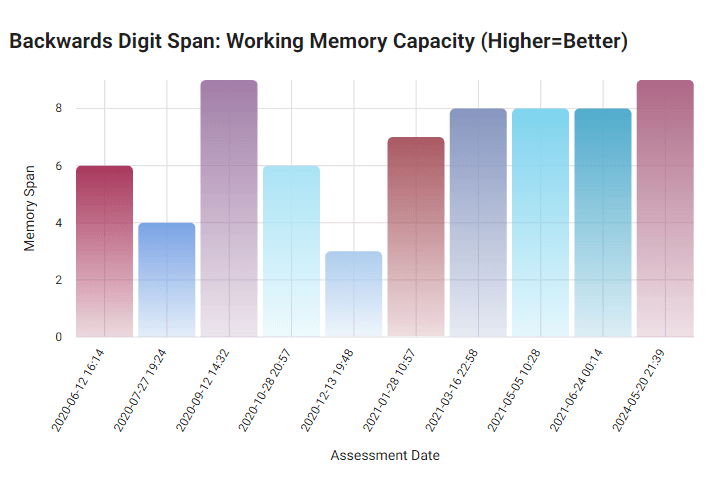
Harper, 75 years old Has been consistently training for over 3 years, since July 2021!
Harper has completed 583 training sessions, 3-4 times a week on average, and hasn’t trained in stand-alone mode since 2022. She has taken 5 assessment tests and significantly improved her working memory capacity usage efficiency – from 5 to 7 digits that she can remember! An increase of 40% in working memory efficiency.
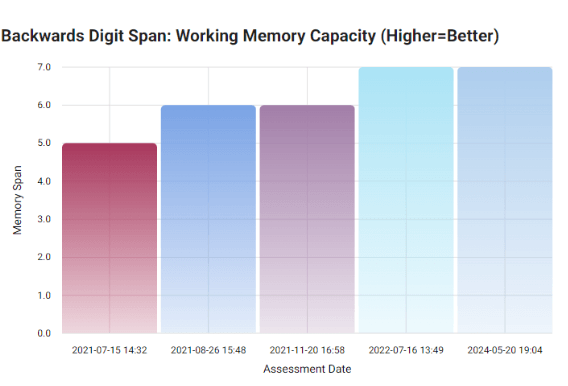
Let’s Break It Down
your 14 day free trial
get to know the software and the content offered within it thoroughly.
free software experience training is available.
the software will adjust the level of difficulty based on your performance.
The Visionaries Behind Our Mission

Shai Garnot, the founder and CEO of Effectivate, realized how much technology can change lives when he encountered dementia in his family. His personal experiences motivated him to develop technological solutions for improving the quality of life of people with cognitive decline.
“Our mission at Effectivate is to create hope and change lives, not just develop software. Come and join us as we improve the cognitive health of future generations”

Anna Izoutcheev, graduated with a bachelor’s degree in communication and pAnna Izoutcheev, graduated with a Bachelor’s degree in communication and psychology and a Master’s degree in cognitive and brain sciences. The product manager and the scientific manager of Effectivate.sychology and a master’s degree in cognitive and brain sciences. The product manager and the scientific manager of Effectivate.
“Our brains have an amazing ability to learn at any age. In the right way we can get much more out of it and maintain our cognitive health”
The Brains Behind the Software
Effectivate has harnessed brain researchers, clinical neuropsychologists, artificial intelligence developers, and UX experts to create this software. The goal is to combine scientific and technological knowledge to create a computerized cognitive training program that addresses difficulties in retrieving words, damage to short-term memory, and other abilities that decline with age.
FAQ
Effectivate allows those interested in the software to access a free trial training without any obligation. The trial training will not be personalized, because the software needs a longer period of time to learn the user, but allows you to get a taste of the training experience.
Effectivate’s system focuses on the cognitive functions which tend to weaken with age, specifically working memory, information processing and retrieval, executive functions (such as cognitive flexibility and inhibition) and visual attention.These abilities have a cumulative effect on daily functions and the quality of life, as they are essential to greater abilities such as money management, mobility, orientation, and much more.
You can access our training from any device: smartphone, tablet, desktop or laptop. We recommend using a computer or tablet because they allow presentation on a larger screen.
In order to support the system optimally, we recommend using a device from the last 5 years.
The answer to this question is divided into two parts.First, the general concept of cognitive training has been examined in many studies, including meta-analyses (an analysis that combines multiple studies), which found that cognitive training is effective for the functions it trains, and is transferable to other functions.The second part of the answer refers to studies done specifically on Effectivate. As of the end of 2023, one study has been published in a peer-reviewed scientific journal. The study, led by Professor Boaz Ben David from Reichman University, tested the effectiveness of Effectivate’s cognitive training in creating an improvement in a task that was not trained on – what is known as “far transfer”.The researchers’ conclusion is that the findings indicate that there was a far transfer as a result of the Effectivate training. The potential impact on daily life is enormous: a quarter of a second is what can make the difference between missing words that are said in a conversation and finally giving up and dropping out, to being able to stay involved in the conversation for a long time.
We recommend between 2 and 3 training sessions per week, You can choose between 7 and 22 minutes for each workout. Thus, you can keep your mind sharp by practicing 15 minutes a week.

Get Your Free Trial Now